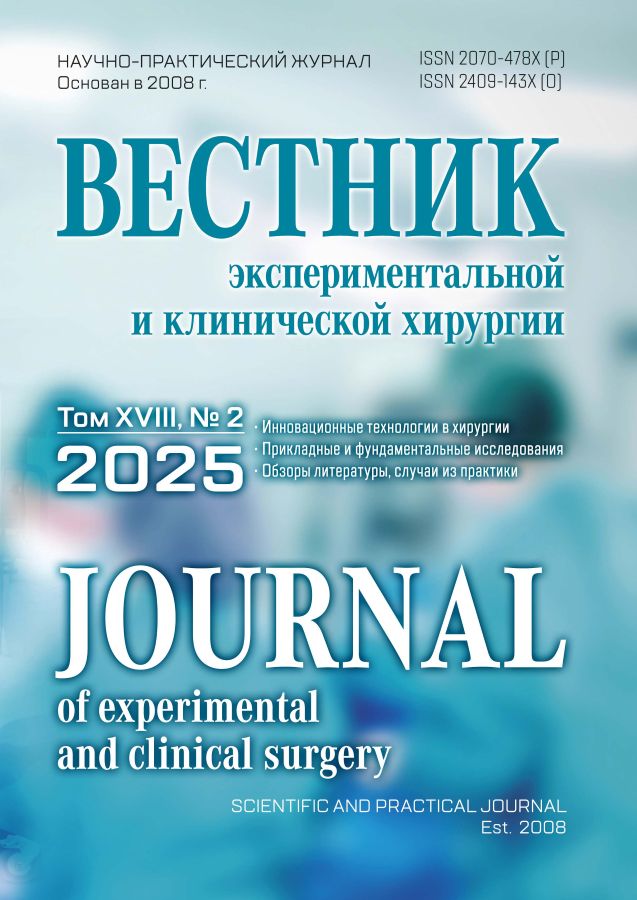Vol 18, No 2 (2025)
Original articles
Markers of Innate and Adaptive Immunity and Biochemical Parameters in Patients Undergoing Cardiac Surgery under Artificial Circulation and High-Volume Hemodiafiltration
Abstract
Introduction. A systemic inflammatory response is one of the complications of cardiac surgery under artificial circulation. It can become an important link in the formation of a critical condition involving multiple organ failure. Controlled continuous high-volume hemodiafiltration was used to eliminate negative consequences in patients undergoing cardiac surgery under artificial circulation. The study of dynamic changes in the parameters of innate and adaptive immunity, biochemical parameters allows assessing the risk of developing a systemic inflammatory response and evaluating the protective effect of hemofiltration.
The aim and objectives of the study were: to measure the parameters of innate and adaptive immunity, biochemical parameters in patients before surgery (on the day of its implementation), in 3 and 10 days after the combined effect of cardiac surgery under artificial circulation using controlled continuous high-volume hemodiafiltration; to evaluate the obtained measurements comparing the immune and biochemical statuses between different study periods and the parameters of healthy donors.
Methods. Phenotypic analysis of lymphoid and phagocytic cells was performed by flow cytometry using monoclonal antibodies (AB) from BD Biosciences, Becton, Dickinson and Co. (USA), labeled with FITC (fluorescein isothiocyanate) or PE (phycoerythrin), on a FACSCalibur flow cytometer (Becton Dickinson, USA). A wide panel of applied monoclonal AB and other markers is presented in Table 1. During the phenotypic analysis, the blood formula was evaluated using a standard approach, biochemical studies were performed on an automatic biochemical analyzer ARCHITECT c4000 (ABBOTT, USA) using reagents from the same company. Statistical analysis of the results was performed using the Prisma 7 program.
Results. The article presents results of 24 patients who underwent surgery for various cardiovascular pathologies under artificial circulation (AC). Controlled continuous high-volume hemodiafiltration was used to eliminate negative consequences in patients undergoing cardiac surgery under artificial circulation. Clinical, biochemical and immune assessment of the health status of patients was carried out in dynamics: before the operation (on the day of its implementation) and in 3 and 10 days. The comparison group consisted of 32 primary donors. Comparative analysis allowed assuming the development of the inflammatory process in patients on the 3rd day after the combined effect of cardiac surgery under AC with the use of controlled continuous high-volume hemodiafiltration. In 10 days after the surgery, the manifestations of inflammation still remained, but the inflammatory reaction was declining, and no generalized systemic inflammatory response developed. The same pattern was observed when analyzing the absolute content of three subpopulations of monocytic cells in patients.
Conclusion. The combined effect of cardiac surgery under AC with the use of controlled continuous high-volume hemodiafiltration allows assuming that the development of a systemic inflammatory response might be prevented; this is apparently due to the eliminated negative effect of CPB.
 80-89
80-89


A Model of Median Ventral Hernia in Acute Experiment
Abstract
Introduction. The treatment of ventral hernia is still of great current interest. If faced with large hernias, a surgeon addresses two problems that can worsen clinical outcomes: intra-abdominal hypertension and excessive tissue tension when suturing the wound. Experimental testing of various hernioplasty techniques considering the tension of the edges of the simulated hernial defect and intra-abdominal pressure is of great importance for improving clinical outcomes of surgical treatment and reducing the number of relapses. Modern hernioplasty techniques are to be thoroughly analyzed in terms of their effectiveness and impact on damaged tissues. Study of the tension mechanics, load distribution on the sutures, dynamics of intra-abdominal pressure during surgery allows identifying the most optimal techniques, which significantly increases the potential successful outcomes of the intervention.
The aim of the study was to create and test a simulated ventral hernia with controlled indices of intra-abdominal hypertension and aponeurosis tension in an acute experiment in animals.
Materials and methods. The study involved 15 pigs weighed 30-35 kg. A special device consisting of an elastic balloon fixed on a tube, a manometer and a squeeze pressure pump was applied to create intra-abdominal hypertension. The tension of the aponeurosis was measured in newtons (N) using an original device equipped with a tensiometer and a monitor.
Results. Intra-abdominal hypertension was simulated by introducing an elastic balloon on a tube into the animal's abdominal cavity through a mini-access, through which air was pumped using a squeeze pressure pump. The pressure value was recorded by the manometer. With total longitudinal dissection of the white line of the abdomen (without damage to the peritoneum), edges of the aponeurosis diverged, which simulated a hernial defect. When intra-abdominal pressure reached 39-41 mm Hg (on average 40,00 ± 0.84) and aponeurosis tension reached 3.8 N, edges of the aponeurosis diverged for three to seven cm (on average 4.9 ± 1.9). One animal with a simulated ventral hernia was exposed to anterior separation plastic surgery according to Ramires II. The tension of the aponeurosis decreased by 52%, intra-abdominal hypertension - by 54%.
Conclusion. The proposed technique for simulating a median ventral hernia allows for an acute experiment, which reduces the time of the experimental study and the material costs associated with the management of the animal. The proposed technique allows not only regulating the initial and final level of aponeurosis tension and intra-abdominal pressure, but also monitoring these parameters at all stages of surgical intervention.
 90-97
90-97


A New Technique for Spleen Resection
Abstract
Introduction. Currently, the concept of preserving the spleen functions is considered generally acknowledged. Among organ-preserving surgeries involving the spleen, resection of the damaged part of the organ is worth noting. Notably, the use of various resection techniques is limited in some cases due to inefficiency and technical complexity.
The aim of the study was to develop experimentally a novel technique for polar wedge resection of the spleen.
Materials and methods. The study involved 29 human cadavers, 54 rabbits (83 items totally). Five of 29 unfixed spleen sections were studied using histotopographic approach, and 24 were subjected to wedge resection of the poles. An option for wedge resection of the spleen was developed in two versions: ligature and adhesive. Each option was tested on 12 sections of the cadaveric spleen. It was found that the optimal angles for performing resection are 45° and 60°. In the first version of the developed technique (ligature), double-row through U-shaped sutures were used; after the edges were brought together, nodal microsurgical sutures were applied to the spleen capsule. The second version of the developed technique (adhesive) included the use of medical surgical glue "Sulfacrylate" and a single-row nodal microsurgical suture on the capsule. The first version of the new technology was used in the rabbits in the first experimental series, and the second version was used in the laboratory animals in the second experimental series. In the rabbits of the third (control) series, the edges of the spleen pole were sutured with a continuous suture with fixation of the greater omentum. The material obtained after experiments on cadavers and laboratory animals was sent for histotopographical examination.
Results. Under both variants of the new technique, histotopograms of the cadaveric spleen poles demonstrated a juxtaposition of histologically homogeneous layers, and the capsule was defined as a continuous line. Reliable hemostasis was achieved in animals of all series. Histotopograms of the spleen poles of rabbits of the experimental series obtained on the 7th, 14th, and 21st days showed a juxtaposition of histologically homogeneous layers, and the capsule was defined as a continuous line. No postoperative complications were observed. In rabbits of the control series, histotopograms showed no juxtaposition of histologically homogeneous layers on the 7th, 14th, and 21st days after surgery, and capsule deformation was observed. Purulent splenic inflammation in the form of a micro-abscess was observed in 2 of 18 (11.1%) rabbits of this series.
Conclusion. A new technology of the spleen resection has been developed in two variants. The use of the new resection technique ensures reliable hemostasis, precise contact of the surfaces being connected, prevents parenchyma cutting, and allows preserving almost the entire functionally active parenchyma.
 98-104
98-104


Review of literature
Pancreatojejunostomy. Evolution of Thinking and Modern Trends
Abstract
Pancreatojejunostomy is a key stage in performing pancreatoduodenal resection, as it is one of the major factors for developing postoperative pancreatic fistulas. The paper demonstrates the evolution of thinking in the global surgical community regarding interventions on the pancreas in general and pancreatodigestive anastomosis in particular. The attitude of pancreatologists to pancreato-digestive anastomosis has undergone radical changes since the end of the 19th century to the present day. For a long time, surgeons were restricted to perform only partial resections of the head of the pancreas, based on the postulates of its inviolability. However, the rapid development of medical technologies and surgical art throughout the 20th century led to the formation of an algorithm for pancreatoduodenal resection in its modern version, as well as the creation of numerous techniques for forming an anastomosis between the remnant of the pancreas and the small intestine. The article describes and illustrates the main modern technologies for forming a pancreatic anastomosis. Based on the data of the world literature, modern technologies for pancreatic anastomosis, their features, advantages and disadvantages are assessed. Additional options to prevent pancreatic fistulas during the pancreatojejunostomy are highlighted. Modern techniques for predicting complications during pancreatoduodenal resection are also described.
 105-115
105-115


Autologous Intestinal Reconstruction: What, When, and Why?
Abstract
Post-resection short bowel syndrome, which is manifested as a severe intestinal failure, is a pressing medical and social problem due to persistent intestinal dyspepsia and progressive, sometimes life-threatening, malnutrition in these patients, leading to their early disability and long-term dependence on parenteral nutrition and maintenance infusion therapy. The introduction of modern parenteral nutrition technologies into clinical practice, which can be successfully carried out by patients self-dependently at home, has significantly changed the quality of life and ensured relatively long survival of the patients. However, parenteral nutrition can have a number of complications (catheter-associated bloodstream infection, venous thrombosis, hepatopathy, etc.), which requires a complex of therapeutic measures aimed at achieving enteral autonomy in these patients, significantly reducing or eliminating the need for intravenous support. One of the most essential areas that contributes to the achievement of enteral autonomy in this category of patients is autologous intestinal reconstruction surgery (AIRS).
The aim of the review is to summarize and systematize the accumulated current information on various options for surgical treatment of patients with post-resection short bowel syndrome and intestinal failure (SBS-IF) using various surgical techniques.
 116-130
116-130


Blunt Liver Injury: from Non-Operative Management to Transplantation. Systematic Review and Meta-Analysis. Part II: Secondary Control Points
Abstract
Introduction. High incidence of blunt liver injuries, a large number of postoperative complications dictate the need to find optimal treatment options for patients’ management.
The aim of the study was to conduct a systematic review of the literature and meta-analysis to compare various treatment options for patients with blunt liver injury.
Methods. A systematic search for non-randomized studies was conducted from October 1, 2015, a systematic search for randomized studies were conducted without time restrictions, up to February 29, 2024.
Results. There is a clear trend towards non-operative management of hemodynamically stable or stabilized patients, supplemented by angioembolization if necessary.
Conclusion. More adequately-designed randomized clinical trials are needed to specify the treatment approach for patients with liver injuries.
 131-160
131-160


Modern Approach to Ventral Hernia Treatment in Female Patients of Child Bearing Age
Abstract
The question of choice of the treatment method for female patients with ventral hernia, however planning to get pregnant, is quite essential. Neither Russian, nor foreign clinical guidelines include indications and contraindications for mesh repair in this category of patients.
We have made a detail review of publications, focused on experimental data as well as on clinical aspects of choice of the surgical approach and the possibilities of mesh repair in ventral hernia treatment for female patients of child bearing age.
 161-165
161-165


Anesthesia and Analgesia in Laboratory Rats: Combinations of Drugs Applied, their Effects on Animals, Optimal Solutions for Reducing Side Effects
Abstract
Currently, a great number of research studies, including those involving surgical interventions, is carried out on experimental models demonstrating pathological processes in rats. In this regard, there is a need for effective and time-controlled techniques of anesthesia and analgesia applicable to a selected group of animals, with subsequent assessment of the anatomical and physiological effects of the selected drug combination. The available options for general anesthesia are distributed in a wide range by the nature of their effect, the duration of action, the process of postoperative recovery within the framework of specific experimental models. This provides relevant search for the most effective and safe drugs. The article discusses the principles of anesthesia in experimental animals (rats), and the most common drugs and their combinations, including isoflurane, a combination of ketamine-xylazine and other ketamine combinations; the effect of a combination of medetomidine, midazolam and butorphanol, the effect of sodium phenobarbital and the use of chloralose are described. All the above drugs are used for anesthesia and analgesia during surgical interventions on experimental models. Notably, besides anesthetic and analgesic effects on the animal's body, they also cause changes in a number of physiological functions, including the work of the heart, brain and respiratory organs, thus, being key factors in the deterioration of the recovery process of animals in the postoperative period or causing animals’ death during the experiment.
 166-175
166-175


Некролог
Vinnik Yuri Semenovich (March 10, 1948 – June 6, 2025)
 176-176
176-176
















